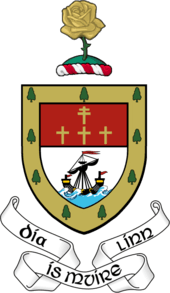Binghamstown
Binghamstown (Irish: an Geata Mór) is a townland and village in County Mayo, Ireland. It lies on the R313 regional road on the Mullet Peninsula, near the town of Belmullet.
History
The townland was originally called Ballymacshedon (the anglicisation of an Irish name), before being renamed Binghamstown.[1] In 1795 Richard Bingham built a castle on the northern reaches of Elly Bay on the Mullet peninsula in Erris, County Mayo.
It was built in castellated style with the offices and gardens commensurate with the full extent of the building. Nothing substantial survives of Bingham castle except for low grass covered foundations. A portion of the castle was pulled down in 1929, and the remainder was subsequently removed over a period of years and the stone used to build later dwellings in the locality.
The town itself was built in 1796 by Major Denis Bingham, and it was built essentially as a "landlord village" providing services for the Bingham estate. It was not until 1817 that a main road was constructed into Erris from Castlebar and it was only in 1824 that it finally ran through Binghamstown to the extremity of the peninsula.
In an attempt to keep the Binghamstown fair alive Major Bingham erected a huge gate across the roadway. Those who took their animals out of Binghamstown to the Belmullet fair had to pay a toll as they passed through the gate, giving rise to the Irish name an Geata Mhór (the Big Gate) for Binghamstown. By the end of the nineteenth century, Binghamstown fell into disuse as a fair town.
References
- Placenames Database of Ireland (see archival records)
Sources
- McCalmont, Rose Elizabeth (1995), Memoirs of the Binghams, Spottiswoode, London
- Fraser, James (1844), A Handbook for Travellers In Ireland, William Curry, London, page 481
